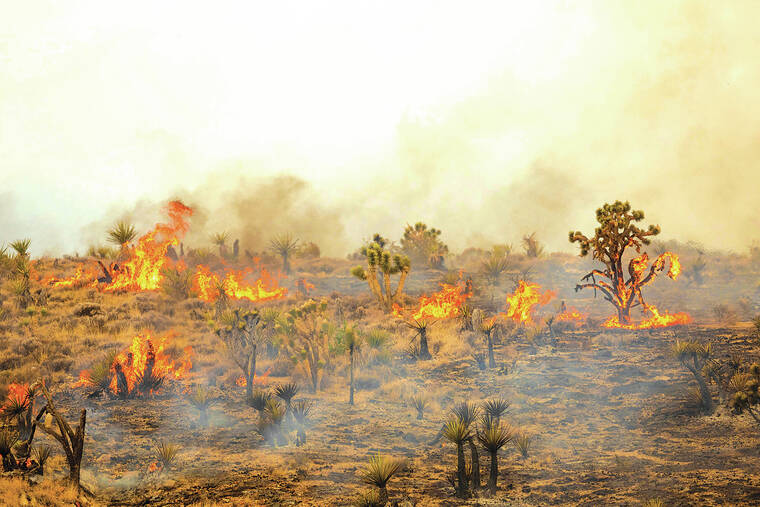Crews are battling ‘fire whirls’ in California’s Mojave Desert
MOJAVE NATIONAL PRESERVE, Calif. (AP) — Crews battled “fire whirls” in California’s Mojave National Preserve as a massive wildfire crossed into Nevada amid dangerously high temperatures and raging winds.
The York Fire was mapped at roughly 120 square miles (284 square kilometers) on Monday night, with no containment.
ADVERTISING
The blaze erupted Friday near the remote Caruthers Canyon area of the vast wildland preserve, crossed the state line into Nevada on Sunday and sent smoke further east into the Las Vegas Valley.
A smoky haze blotted out the sun midday on the Las Vegas Strip and obliterated views of mountains surrounding the city and suburbs. Because of low visibility, the Harry Reid International Airport in Las Vegas reported departure delays of nearly two hours.
A fire whirl — sometimes called a fire tornado — is a “spinning column of fire” that forms when intense heat and turbulent winds combine, according to the National Park Service.
The vortexes — which can be anywhere from a few feet tall to several hundred feet high, with varying rotational speeds — were spotted Sunday on the north end of the York Fire.
“While these can be fascinating to observe they are a very dangerous natural phenomena that can occur during wildfires,” the park service wrote.
The whirls require high temperatures to form. In Searchlight, Nevada — an unincorporated area about 12 miles (19.31 kilometers) from the California border where the fire burned — Monday’s high was 100 degrees Fahrenheit (37.8 Celsius), according to the National Weather Service.
Significant portions of the U.S. population have been subject to extreme heat in recent weeks. Worldwide, July has been so steamy thus far that scientists calculate it will be the hottest month ever recorded and likely the warmest to hit human civilization.
Wind-driven flames 20 feet (6 meters) high in some spots charred tens of thousands of acres of blackbrush scrub, pinyon-juniper woodlands and the famous Joshua trees in the New York Mountains in San Bernardino County.
Ileene Anderson, a senior scientist at the Center for Biological Diversity, said it could take the pinyon-juniper woodlands 200 to 300 years to become “a functional community again,” while the blackbrush scrub and Joshua trees are unlikely to regrow after this catastrophic blaze, which erupted without human intervention.
“It will change the habitat possibly permanently,” Anderson said.
Even more, deer and bighorn sheep could become trapped by the flames, she said. If any manage to survive the blaze, their resources in the newly scorched landscape would be severely limited.


